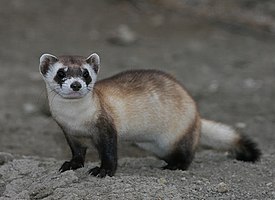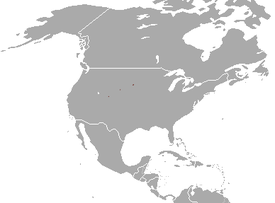American ferret , or black-footed ferret [1] ( Latin Mustela nigripes ) is a small North American predator , a close relative of the Russian steppe ferret and other representatives of the marten family. By 1937, the black-footed ferret was completely exterminated in Canada, and since 1967 is included in the Red Book of North America as an endangered species. In the mid-1980s, the last known wild population of ferrets was caught and transported to the territory of the research base for artificial breeding. Now the release of the black-footed ferrets into its former US habitat is called the “amazing return."
| American ferret |
 |
| Scientific classification |
|---|
| No rank : | Bilateral symmetrical |
| Gender: | Weasels and ferrets |
|
| International scientific name |
|---|
Mustela nigripes Audubon & Bachman , 1851 |
| Area |
|---|

|
| Security status |
|---|
Endangered speciesIUCN 3.1 Endangered : 14020 |
|
The black-footed ferret is approximately 45 cm long, with a furry 15 centimeter tail, weighs 650-1400 g. Like most members of this family, Mustela nigripes have a squat, elongated body with very short paws. Their fur, white at the base, becomes darker at the ends of the hairline and gives the animal an overall tan color. The legs and end of the tail are black, and the black-legged ferret also has a “black face” mask, characteristic of many ferrets. This color scheme helps ferrets to be invisible in the habitat.
The black-footed ferret is a nocturnal predator, like other ferrets that need an abundance of prey - meadow dogs ( English prairie dogs ), its main food object. However, the ferret also feeds on other small animals, birds , large insects , etc. One family of black-footed ferrets eats about 250 meadow dogs a year and cannot survive without access to large colonies of these rodents. A typical colony of meadow dogs lives on 50 hectares of prairies and satisfies the nutrition of only one adult ferret. Ferrets completely depend on their survival on the colonies of meadow dogs, since they not only feed on them, but also live in their burrows, hiding from danger.
US federal and state agencies , in collaboration with private landowners, conserve the black-footed ferret in the wild by releasing captive-bred ferrets, zoos and scientific and zoological centers in their natural habitat. The places of release were the States of Montana , South Dakota , Arizona , Utah , Colorado and Chiufua Mexico .
In 1981, a small settlement of 130 animals was discovered near Meeteetse, Wyoming .
Immediately after the opening of this ferret settlement, more than half of the ferrets died due to the disease. It was decided to save the fate of the black-footed ferrets to catch 18 individuals of different sexes and place them on the territory of the scientific and zoological center.
According to information on the state of affairs with the black-footed ferret in 2007, its number exceeds 600 units in the United States. Although it is still considered an endangered species according to the old estimate of 1996, since at that time ferrets lived only in captivity with a group of specialists.
The recovery plan for the ferret population in his native environment considers it his ultimate task to establish 10 or more separate, self-surviving wild settlements. Biologists hope to get 1,500 black-footed ferrets free by 2010 with at least 30 breeding adults in each settlement.



